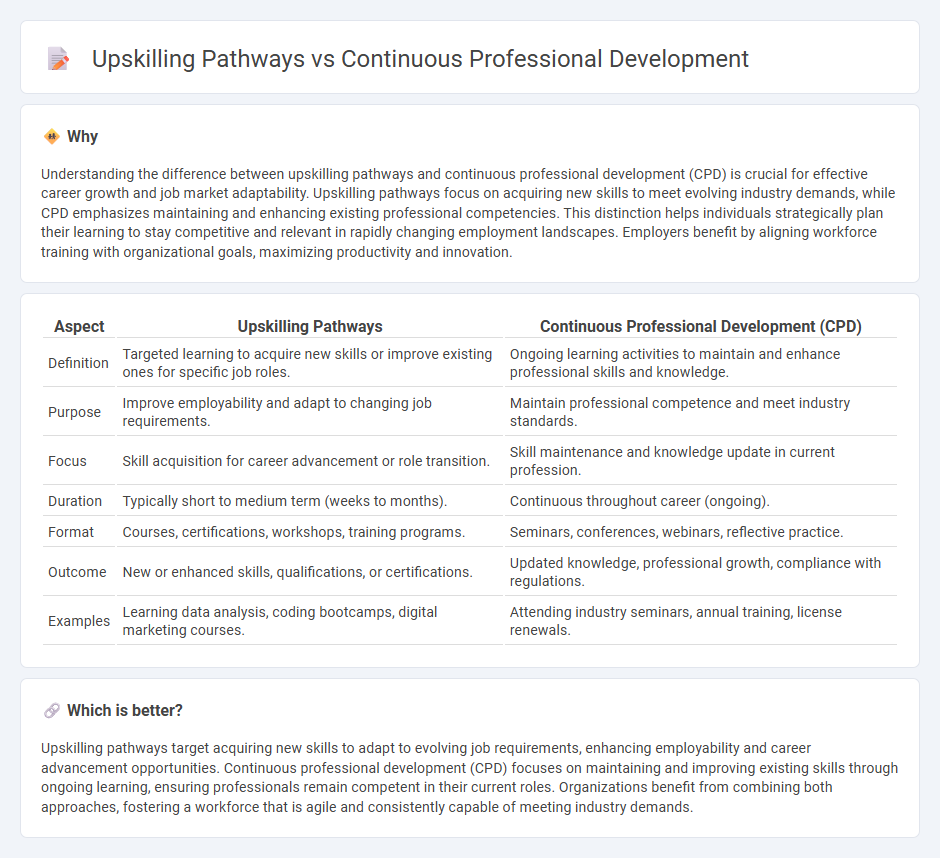
Upskilling pathways focus on acquiring new skills to meet evolving job market demands, enhancing employability and career advancement opportunities. Continuous professional development (CPD) emphasizes ongoing learning and skill refinement to maintain professional competence and adapt to industry changes. Explore the benefits of each approach to optimize your career growth strategies.
Why it is important
Understanding the difference between upskilling pathways and continuous professional development (CPD) is crucial for effective career growth and job market adaptability. Upskilling pathways focus on acquiring new skills to meet evolving industry demands, while CPD emphasizes maintaining and enhancing existing professional competencies. This distinction helps individuals strategically plan their learning to stay competitive and relevant in rapidly changing employment landscapes. Employers benefit by aligning workforce training with organizational goals, maximizing productivity and innovation.
Comparison Table
| Aspect | Upskilling Pathways | Continuous Professional Development (CPD) |
|---|---|---|
| Definition | Targeted learning to acquire new skills or improve existing ones for specific job roles. | Ongoing learning activities to maintain and enhance professional skills and knowledge. |
| Purpose | Improve employability and adapt to changing job requirements. | Maintain professional competence and meet industry standards. |
| Focus | Skill acquisition for career advancement or role transition. | Skill maintenance and knowledge update in current profession. |
| Duration | Typically short to medium term (weeks to months). | Continuous throughout career (ongoing). |
| Format | Courses, certifications, workshops, training programs. | Seminars, conferences, webinars, reflective practice. |
| Outcome | New or enhanced skills, qualifications, or certifications. | Updated knowledge, professional growth, compliance with regulations. |
| Examples | Learning data analysis, coding bootcamps, digital marketing courses. | Attending industry seminars, annual training, license renewals. |
Which is better?
Upskilling pathways target acquiring new skills to adapt to evolving job requirements, enhancing employability and career advancement opportunities. Continuous professional development (CPD) focuses on maintaining and improving existing skills through ongoing learning, ensuring professionals remain competent in their current roles. Organizations benefit from combining both approaches, fostering a workforce that is agile and consistently capable of meeting industry demands.
Connection
Upskilling pathways and continuous professional development (CPD) are intrinsically connected as both focus on enhancing employees' skills to meet evolving job demands. Upskilling pathways provide structured learning opportunities aligned with industry standards, while CPD ensures ongoing growth through certifications, workshops, and training programs. Integrating these approaches boosts workforce adaptability, increases productivity, and supports long-term career advancement in competitive employment markets.
Key Terms
Lifelong Learning
Continuous professional development (CPD) emphasizes ongoing education and skill enhancement throughout a career to maintain professional competence, while upskilling pathways target acquiring new skills to adapt to changing job demands and technologies. Both CPD and upskilling play essential roles in lifelong learning by fostering adaptability, knowledge retention, and career growth in dynamic industries. Explore how integrating CPD with targeted upskilling can maximize your lifelong learning potential and career advancement.
Skills Gap
Continuous professional development (CPD) focuses on ongoing learning to maintain and enhance existing skills, while upskilling pathways target acquiring new, relevant skills to address specific skills gaps in the workforce. Organizations use CPD and upskilling strategies to improve employee performance, adapt to technological advancements, and close critical skills gaps impacting productivity. Explore more insights on optimizing these learning approaches to effectively bridge skills gaps and drive career growth.
Career Progression
Continuous professional development (CPD) involves ongoing learning activities that enhance existing skills and knowledge essential for career growth, while upskilling pathways focus on acquiring new competencies to meet evolving industry demands and transition into advanced roles. Both approaches contribute significantly to career progression by increasing employability, job performance, and adaptability in dynamic work environments. Explore detailed strategies on how CPD and upskilling can accelerate your professional advancement and career trajectory.
Source and External Links
What is Continuing Professional Development (CPD)? - Continuous Professional Development (CPD) is an ongoing process where professionals enhance their skills, knowledge, and competencies through diverse learning activities such as courses, seminars, workshops, and eLearning, aiming to improve workplace performance and career progression throughout their lives.
What is Continuing Professional Development (CPD)? - CPD is the continuous process of developing and maintaining professional skills, delivered through formal courses or informal methods like mentoring and on-the-job observation, essential for keeping professionals skilled and relevant in their fields.
What Is Continuous Professional Development? - Continuous Professional Development is a lifelong commitment to regularly updating professional expertise through workshops, seminars, courses, and self-directed learning in order to stay current, adaptive, and competitive in a rapidly evolving workplace environment.
 dowidth.com
dowidth.com